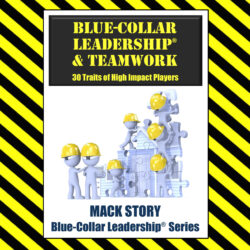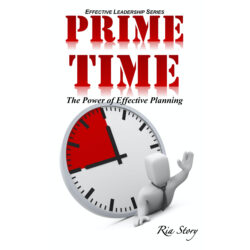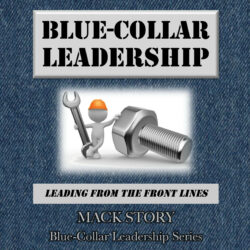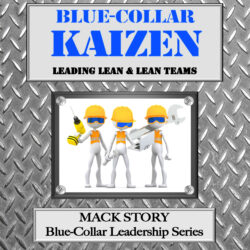Note: The following is an excerpt, Chapter 5, from one of my newest books, Blue-Collar Leadership & Supervision: Unleash Your Team’s Potential. The format is 30 easy-to-read, three page chapters. It’s perfect for leading your leaders through a 30 day book study one short chapter per day.
Defining your leadership style
Do others follow you because they have to or because they want to?
“I suppose leadership at one time meant muscles; but today it means getting along with people.” – Mahatma Gandhi
You’re given a position, and you’re told what and who to manage. But, how you lead is up to you. The position does not define you. You define the position. Your values will determine if people follow you because they have to or because they want to. It’s all about your style. How do you operate?
No one but you can, or will, determine your leadership style. When it comes to climbing the leadership mountain, your leadership style can launch you like a rocket, or it can hold you back like an anchor. Your values will determine your style. Who you are on the inside is what people will experience on the outside.
Most often, the managers who hired me when I worked as a process improvement consultant typically thought I was extremely gifted and could do amazing things.
Actually, I usually didn’t know very much about what they were doing, how they were doing it, or why they were doing it.
I want to share a story to illustrate two very different leadership styles based on two very different values.
The manager in this story had over 30 years of experience in their operations. I didn’t have any.
What I do have is a very effective leadership style that allows me to quickly connect with and influence people. This enables me to get their buy-in quickly, to get them to work together quickly, and to unleash the potential within them that their managers don’t even know they have. Any high impact leader can do the same thing.
I was leading a process improvement event as an outside consultant. The team’s goal was to redesign the layout of a manufacturing work area to improve the work flow in order to make the process more productive.
A lot of changes were needed. It had been the way it was for many years. I was brought in by the top leaders, so everyone had to play along. They didn’t have to change. If they didn’t want to, they could have blamed me. They would have been right because I was the leader. I simply wouldn’t have been invited back because I was ultimately responsible.
When I arrived on Monday morning, I was a stranger. I didn’t have any formal authority. I was basically a hired leader, but the manager that hired me didn’t understand that. If they would have, they wouldn’t have hired me. First of all, they wouldn’t have needed me. They would have already developed a team of internal leaders. And secondly, they would be out making things happen themselves.
Remember, I was new to the area. It was my first day on the job working with the team. Everything that happened or didn’t happen that week was a direct result of my leadership style. I didn’t have a clue about what they were producing. But, I knew they did. Without formal authority, my only option was to lead with influence by applying the principles I’m teaching you in this book. However, I had to do it quickly. I was only going to be with the team from start to finish for five days. We would not be planning. We would be doing.
My style involved coming in on Monday and immediately connecting with the team and conducting leadership training with them. I wanted to get to know them. I wanted them to get to know me. And, I wanted to share key leadership principles to get them in the right mindset to achieve amazing results together. I had done this many times before. It wasn’t new for me, but it was new for the manager.
The manager, who was also a team member, had never participated in an event like the one I was leading. He didn’t know what he didn’t know. However, his style was built on a foundation of pride and ego. He wanted those on the team to know he was the boss. The first thing he did when I started connecting with the team was roll his eyes. He was a manager of people. Then, he proceeded to let the team know we were wasting time. He thought we should be out on the shop floor making changes. After all, in his mind, that was the only reason we were there.
The manager’s style was to come in and take control of the team. My style was to come in and empower the team. They had been controlled long enough. The manager’s style was to give orders and do all the talking. My style was to ask questions and do all the listening. This was the type of environment where I truly learned to be a high impact leader. Situations like this were common as I built up over 11,000 hours of experience leading cross-functional teams through change.
Don’t miss the point, this manager “owned” the area. He could have already made any changes he wanted. He didn’t want changes. But, if changes were going to be made, he wanted to be in charge of those making them. Managers value being in control. Leaders value letting the team be in control.
I immediately focused on building trust with the team. I also ignored the manager’s need for control and leveraged his strengths to benefit the team. He was there all week, but he had very little influence beyond his authority. He wanted to be in charge, and formally was, but I had the most influence. Positive influence trumps negative authority every time!
We made it happen in spite of his inability to lead and his desire to manage. He didn’t have to know how to lead that week, I was doing the leading. He simply needed to follow.
The team delivered amazing results! They already had all the answers and knew what needed to be done. They simply hadn’t been allowed to do it. My style of leadership released them. The manager’s style had suppressed them. Style matters, and it matters a lot!
“Nobody wants a boss. Everyone wants a coach.” ~ Art Williams





















